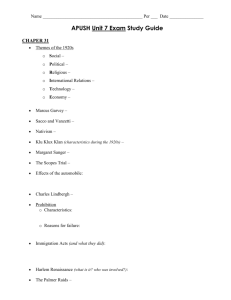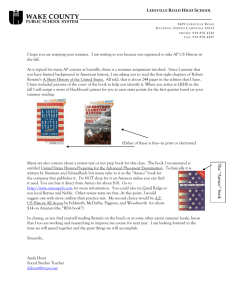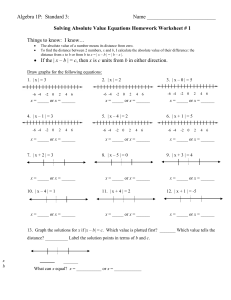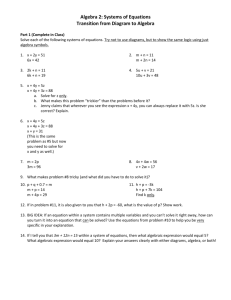H Integrated Algebra Outline - Math K-12
advertisement
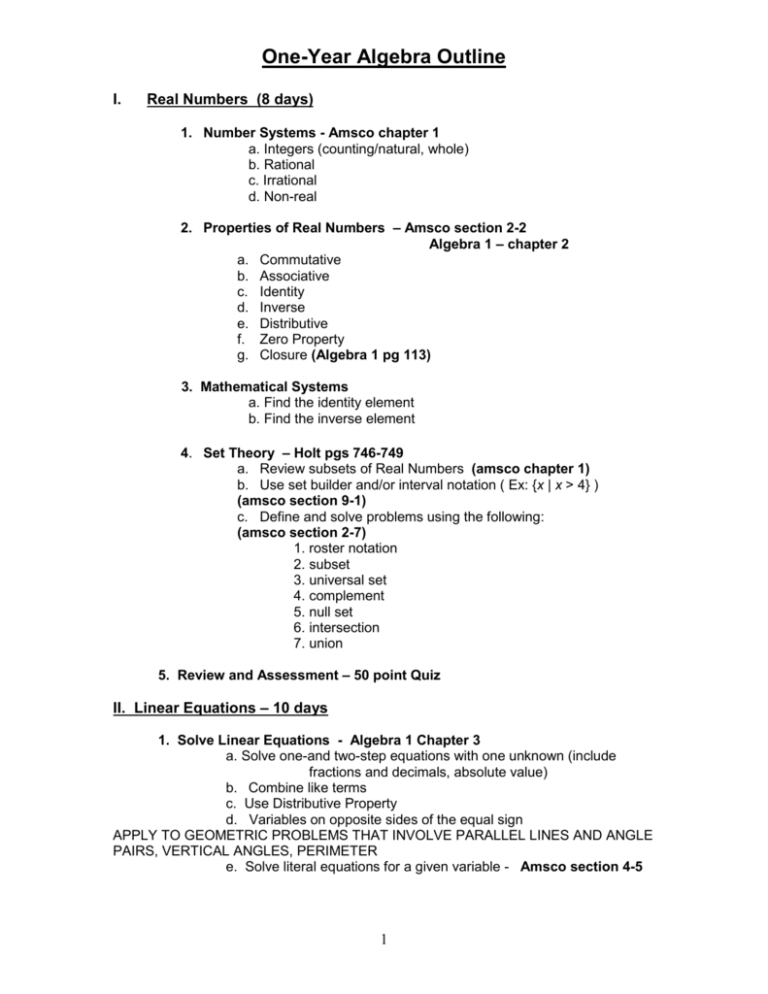
One-Year Algebra Outline
I.
Real Numbers (8 days)
1. Number Systems - Amsco chapter 1
a. Integers (counting/natural, whole)
b. Rational
c. Irrational
d. Non-real
2. Properties of Real Numbers – Amsco section 2-2
Algebra 1 – chapter 2
a. Commutative
b. Associative
c. Identity
d. Inverse
e. Distributive
f. Zero Property
g. Closure (Algebra 1 pg 113)
3. Mathematical Systems
a. Find the identity element
b. Find the inverse element
4. Set Theory – Holt pgs 746-749
a. Review subsets of Real Numbers (amsco chapter 1)
b. Use set builder and/or interval notation ( Ex: {x | x > 4} )
(amsco section 9-1)
c. Define and solve problems using the following:
(amsco section 2-7)
1. roster notation
2. subset
3. universal set
4. complement
5. null set
6. intersection
7. union
5. Review and Assessment – 50 point Quiz
II. Linear Equations – 10 days
1. Solve Linear Equations - Algebra 1 Chapter 3
a. Solve one-and two-step equations with one unknown (include
fractions and decimals, absolute value)
b. Combine like terms
c. Use Distributive Property
d. Variables on opposite sides of the equal sign
APPLY TO GEOMETRIC PROBLEMS THAT INVOLVE PARALLEL LINES AND ANGLE
PAIRS, VERTICAL ANGLES, PERIMETER
e. Solve literal equations for a given variable - Amsco section 4-5
1
One-Year Algebra Outline
2. Translate Among Verbal, Written, and Algebraic
a. Represent words with mathematical expressions and equations
(and vice versa)
Algebra 1 Section 1.5
b. Distinguish between an algebraic expression and an algebraic
equation
c. Write algebraic equations to represent a situation
3. Word Problems whose solution requires solving a linear equation with
one unknown - Amsco Chapter 6, Algebra 1 Section 3.5
a. Consecutive Integer
b. Coin
c. Perimeter
d. Number
4. Review and Assessment
III. Ratios, Rates and Proportion - 5 days
1. Rates and Ratios - Amsco section 6-3, Algebra I section 3.8
a. Ratios and word problems involving ratios and rates
b. Calculate Rates Using Appropriate Units
2. Solve Proportions
a. Conversions Within Measurement Systems Algebra 1 section 3.8
Convert between units
Amsco section 6-7
Solve measurement problems given more than one unit
b. Percent of Increase/Decrease, discount, sales tax word problems
3. Review and Assessment (50 point Quiz)
IV.
Graphs of Linear Equations - 14 days
1. Graphs of Lines - Algebra 1 Chapter 4
a. Graph a line using a table of values
b. Define of a function vs. relation
Algebra 1 section 1.7, 3.7 and 4.8
1. determine if a graph represents a function
2. vertical line test
3. domain and range
c. Determine whether a given point is on a line, given an equation
( Ex: Given (3, 2) is on the graph of x + 3y = k, find k )
d. Solve for an unknown in an equation (or for a coordinate) given
a point on a graph
( Ex: Given (k, 7) is on the graph of x – 7y = 10, find k )
e. Slope
2
One-Year Algebra Outline
1. Define slope as the rate of change
2. Find slope between two points using the formula and
using a graph
3. Identify different slopes (positive, negative, zero and
undefined)
f.
Intercepts (x and y)
1. Find the x- and y-intercepts
2. Write an equation and graph lines parallel to the axes
(Algebra 1 section 5.2)
3. Graph a line using the x and y intercepts (optional)
g. Slope-Intercept Form – Algebra 1 Chapter 5
1. Write the equation of a line given its slope and
y-intercept
2. Convert an equation into slope-intercept form
3. Graph equations using slope-intercept form (include
investigating and generalizing how changing the slope
and y-intercept affects the graph)
4. Determine if two lines are parallel, given their equations
in any form
5. Write the equation of a line, given the coordinates of two
points on the line
h. Write the equation of a line given the slope and the coordinates
of a point. (point-slope form)
i.
Write the equation of a line, given the coordinates of two points
on the line
j.
Direct Variation – Amsco section 6-5
2. Review and Assessment
V.
Linear Inequalities – 6 days
1. Solve Linear Inequalities - Algebra 1 Chapter 6
a. Solve linear inequalities with one variable (include multiplying
and dividing by a negative number) and variables on both sides
1. Graph solutions and discuss interval notation
b. Translate among verbal, written and algebraic
1. Represent words with mathematical inequalities
2. Write algebraic inequalities that represent a situation
c. Analyze and solve word problems whose solution requires
solving a linear inequality with one variable
2. Graphs of Linear Inequalities – 2 variables
a. Determine if reference line is dashed or solid
b. Determine where to shade
3. Review and Assessment
3
One-Year Algebra Outline
VI.
Systems of Linear Equations and Inequalities – 10 days
1. Systems of Equations - Algebra 1 Chapter 7, Amsco Chapter 10
a. Solve graphically and check
b. Solve algebraically and check
1. substitution method
2. elimination method
c. Solve word problems
d. Equations with an infinite number of solutions
such as 2x+4 = 2(x+2)
e. Equations with no solutions such as x + 4 = x + 5
2. Systems of Inequalities
a. Solve graphically
b. Determine whether a given point is in the solution set
3. Review and Assessment
VII. Polynomials – 11 days
1. Scientific Notation - Amsco section 5-7
a. Exponent rules Algebra 1 Chapter 8
1. zero and negative exponents
2. multiplying and dividing rules
b. Convert to scientific notation
c. Convert from scientific notation to standard form
d. Compute products and quotients involving scientific notation
e. Word problems involving scientific notation
2. Operations With Monomials and Polynomials - Algebra 1 Chapter 10
a. Vocabulary – constant, degree, standard form, coefficient,
leading coefficient, like terms
b. Add and subtract monomials and polynomials
c. Multiply and divide monomials (include negative exponents)
d. Distributive Property (include combining like terms)
e. Multiply two binomials
f. Multiply two polynomials
g. Multiply and divide monomial expressions with a common base using
the properties of exponents (use integers as exponents)
h. Divide a polynomial by a monomial or binomial, where the quotient has
no remainder
i. Use the area of shaded regions to illustrate polynomial operations
3. Review and Assessment
4
One-Year Algebra Outline
VIII. Factoring and Algebraic Fractions – 11 days
1. Factoring - Algebra 1 Chapter 10
a.
b.
c.
d.
e.
f.
Factor algebraic expressions using the GCF
Factor a trinomial into two binomials, given a = 1
Factor a trinomial into two binomials, given a >1 (optional)
Identify and factor the difference of two perfect squares
Factor a trinomial into binomials that requires factoring out a
GCF first
Factor a trinomial into two binomials that requires factoring out a
negative GCF first (Ex: –x2 – 3x – 4)
2. Algebraic Fractions - Algebra 1 Chapter 11, Amsco Chapter 14
a. Find the value for which an algebraic fraction is undefined
1. monomial and binomial denominators
2. factorable binomial denominators
b. Simplify fractions with polynomials in the numerator and
denominator by factoring both and reducing to lowest terms
c. Add or subtract fractional expressions
1. like and unlike monomial denominators
2. like binomial denominators (unlike is optional)
d. Multiply and divide algebraic fractions and express the product
or quotient in simplest form
1. monomial divided by monomial
2. polynomial divided by monomial
3. polynomial divided by polynomial
3. Review and Assessment
IX.
Non-linear Functions – 17 days
1. Graph Quadratic Equations – Algebra 1 section 9.3, Amsco 13-2
a. Recognize general form of a quadratic
b. Determine the axis of symmetry using the formula or from the
graph
c. Determine the vertex algebraically or graphically
d. Find the table of values for an equation
e. Graph the equation
f. Explore how coefficient change effects the parabola’s graph
2. Solve Quadratic Equations - Algebra 1 9.4, Amsco 13-3
a. Identify the relationship between the roots of a quadratic
equation and the x-intercepts on the graph of the parabola
b. Find the roots of a parabolic function graphically (integer
solutions)
5
One-Year Algebra Outline
c. Identify the relationship between the number of roots and the
number of x-intercepts
d. Understand and apply the multiplication property of zero to solve
quadratic equations whose coefficients and roots are integers
e. Analyze and solve word problems that involve quadratic
equations
f. Solve algebraic proportions with one unknown that result in
quadratic equations
3. Review and Assessment
4. Solve Systems of Linear and Quadratic Equations
a. Solve graphically - Amsco 13-4
b. Solve algebraically using substitution - Amsco 13-5
5. Exponential Functions - Algebra 1 sections 8.5, 8.6, Amsco 9-11
a. Identify and graph an exponential function (given an un known
in the base or as an exponent )
b. Analyze and solve word problems that involve exponential
growth and decay
6. Absolute Value Functions – Algebra 1 section 6.4, Amsco 9-10
a. Identify and graph an absolute value function
7. Review and Assessment
X.
Plane and Solid Geometry – 13 days
1. Perimeter
NOTE: Include problems that use algebra to find perimeter of the
following figures:
a.
b.
c.
d.
e.
f.
g.
h.
i.
j.
k.
Triangle
Rectangle
Square
Parallelogram
Rhombus
Trapezoid
Circle *leave answers in terms of pi
Semi-Circle *
Quarter- Circle *
Other Regular Polygons
Figures composed of polygons and/or circles or sectors of a
circle
6
One-Year Algebra Outline
2. Area - Amsco 7-6
NOTE: Include problems that use algebra to find perimeter of the
following figures:
a.
b.
c.
d.
e.
f.
g.
h.
i.
j.
Triangle
Rectangle
Square
Parallelogram
Rhombus
Trapezoid
Circle
Semi-Circle
Quarter-Circle
Figures composed of polygons and/or circles or sectors of a
circle
k. Shaded regions
3. Volume - Amsco 7-8
a. Cube
b. Rectangular Prism
c. Cylinder
4. Surface Area - Amsco 7-7
a. Cube
b. Rectangular Prism
c. Cylinder
5. Relative Error – Amsco Pg 289 - 292
a. Calculate the relative error in measuring square and cubic units,
where there is an error in the linear measure
6. Review and Assessment
XI.
Radicals and Right Triangles – 15 days
1. Operations with Radicals - Amsco and Algebra 1 Chapter 12
a. Simplify radicals
a. radicand with a perfect square factor
b. radicands with variables (optional)
b. Add and subtract like and unlike radicands
c. Multiply radicals (include use of distributive property)
d. Divide radicals
2. Pythagorean Theorem - Amsco 8-1, Algebra 1 12.5 and 12.6
7
One-Year Algebra Outline
a. Determine if a triangle is a right triangle
b. Find the third side (radical, rational and irrational) of a right
triangle, given two sides
c. Solve word problems
3. Trigonometric Functions – Amsco Chapter 8
a.
b.
c.
d.
e.
f.
Sine
Cosine
Tangent
Inverse Trigonometric Functions
Find all sides and angles of a right triangle using trig. and/or
Pythagorean Theorem
Solve word problems (include angle of elevation and
depression)
4. Review and Assessment
XII.
Probability ( 8 days) Amsco Chapter 15
1. Define and solve problems using the following:
a.
b.
c.
d.
e.
f.
g.
h.
i.
sample space
simple probability of a single event
probability with “and” (single event)
probability with “or” (single event)
complement
empirical probability (based on specific sample data)
impossible events
certain events
Fundamental Counting Principle
2. Analyze a set of events to determine when:
a. some or all are equally likely to occur
b. one is more likely to occur
c. an event is certain to happen or not to happen
3. Conditional Probability
a. with replacement
b. without replacement
4. Probability of a series of independent and dependent events
a. and
b. or
c. mutually exclusive
d. not mutually exclusive
5. Permutations
a. Define factorial
8
One-Year Algebra Outline
b. Evaluate factorials using formula
c. Permutations with repetition
6. Review and Assessment
XIII. Statistics and Regression – 13 days
Amsco Pgs 660-730
1. Categorize Data - Amsco 16-1 and 16-7
a.
b.
c.
d.
Qualitative
Quantitative
Univariate
Bivariate
2. Measures of Central Tendency -Amsco 16-4 and 16-5, Algebra 1 6.6
a.
b.
c.
d.
e.
f.
Mean
Median
Mode
Appropriate choice of measure
Range
Recognize how linear transformations of one-variable data affect
the data’s mean, median, mode and range
3. Histograms - Amsco 16-2, 16-3
a.
b.
c.
d.
Generate a frequency table
Construct a frequency histogram
Construct a cumulative frequency histogram
Analyze data from a frequency table, histogram, cumulative
frequency table or cumulative frequency histogram
4. Percentiles – Amsco 16-6
a. Definition
b. Find the percentile rank of a value in a set of a data
c. Find the first, second and third quartiles
5. Box-and-whisker Plot - Algebra 1 section 6.7
a. Define as a five-number summary (minimum, maximum,
quartiles)
b. Construct a box-and-whisker plot
c. Analyze data from a box-and-whisker plot
6. Biased Data - Amsco pg 662
9
One-Year Algebra Outline
a. Evaluate reports and graphs for accuracy, appropriateness,
experimental design and soundness of the conclusion
b. Identify and describe sources of bias and its effect, drawing
conclusions from data
7. Scatterplots – Algebra 1 Section 4.1 and 5.4, Amsco 16-7
a. Construct a scatterplot
b. Identify the independent and dependent variables
c. Find the relationship between the variables (positive, negative,
none)
d. Understand the difference between correlation and causation
e. Identify variables that might have a correlation but not a causal
relationship
f. Construct manually a line of best fit
g. Determine the equation of a line of best fit
h. Interpolation and extrapolation
8. Review and Assessment
XIV. Regents Review – 16 days
10

